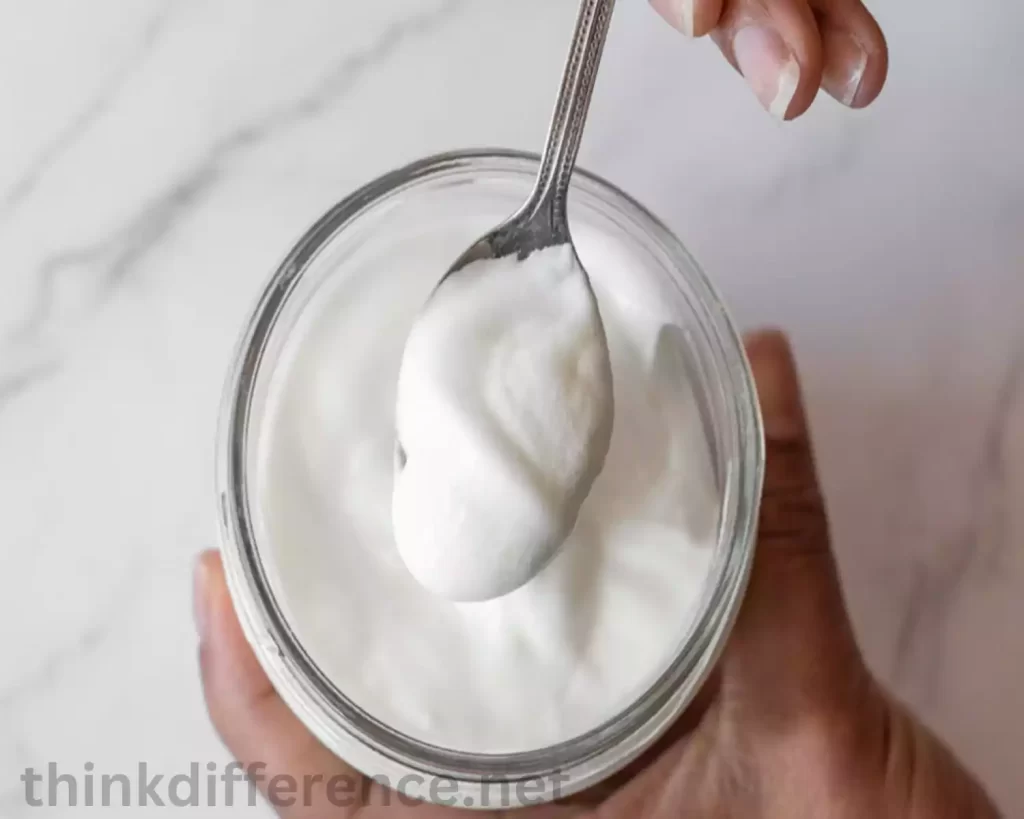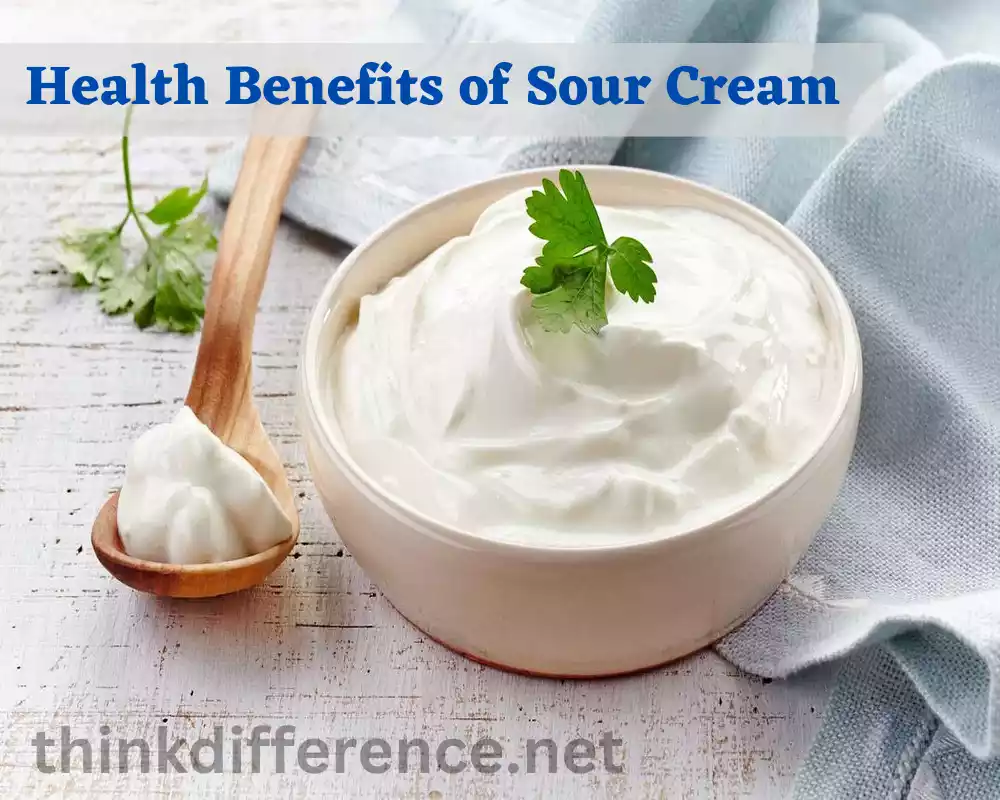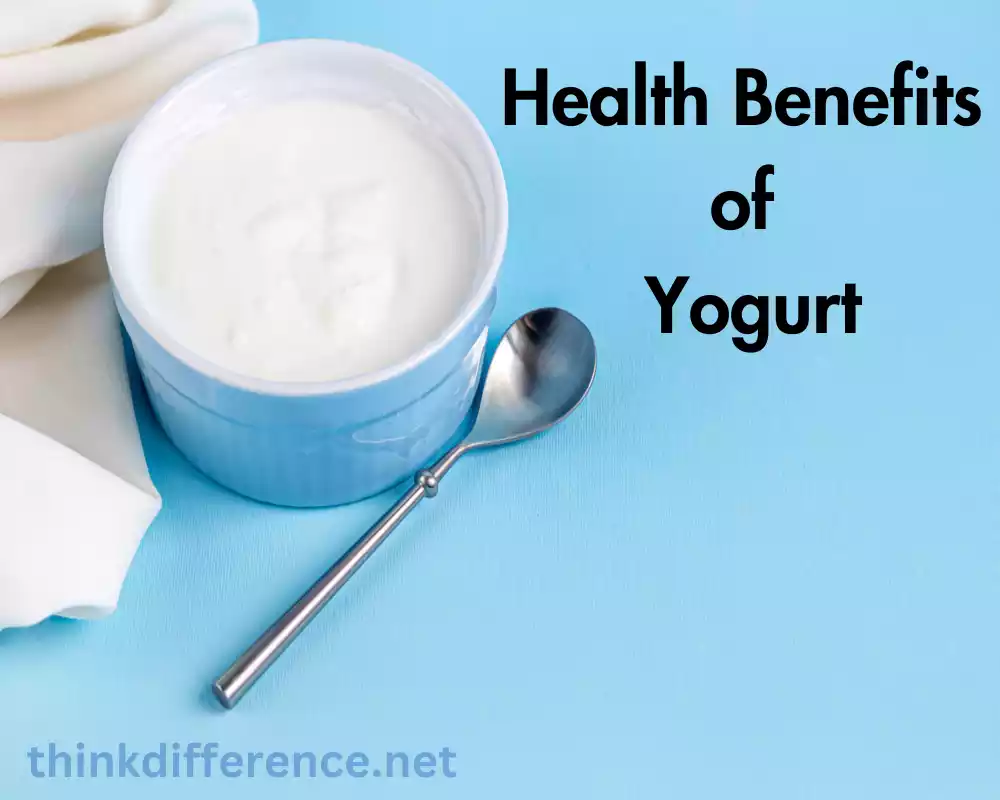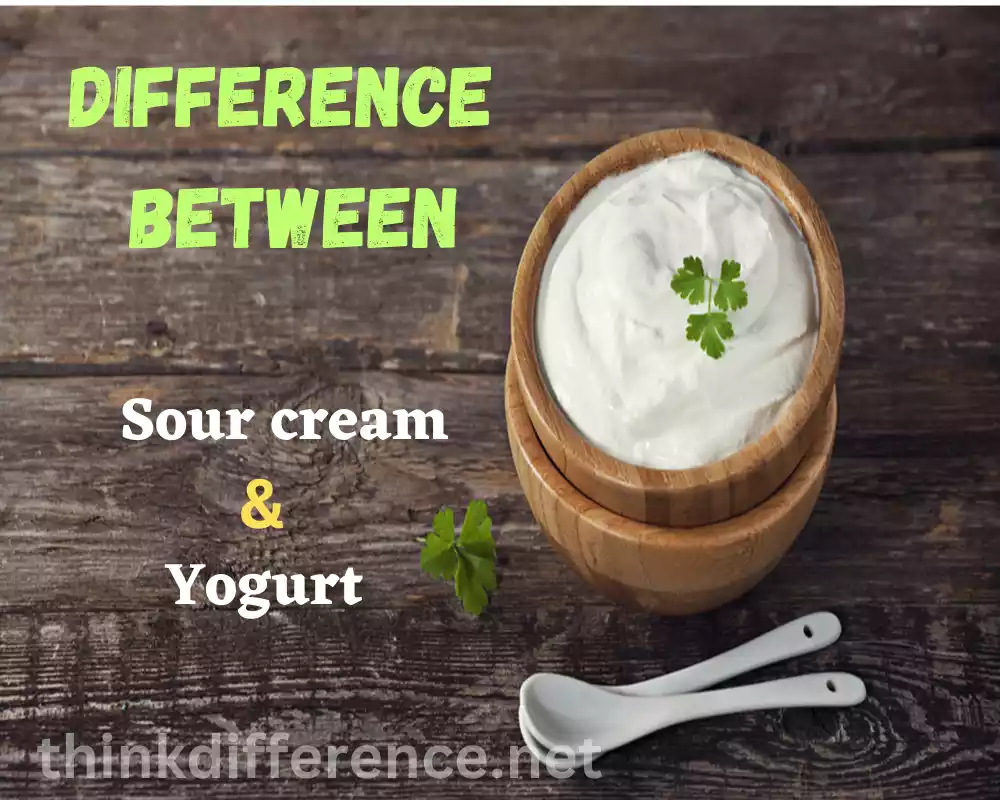Sour Cream and Yogurt are popular dairy products that are widely used in cooking and baking. They both add richness and tanginess to a variety of dishes and are known for their versatility. While they share similarities, there are also notable differences between sour cream and yogurt. This article explores the characteristics, production processes, culinary uses, health benefits, and a comparison between sour cream and yogurt.
What is Sour Cream?
Cream is used in numerous culinary preparations as an ingredient, topping, or condiment. To produce it, cream must be fermented using lactic acids bacteria which gives it its characteristic tart flavor and creamy texture.

Sour cream’s consistency resembles that of yogurt: an off-white or pale yellow hue and smooth, luxurious texture, combined with its tart flavor that adds zesty acidity and zesty acidity that gives any dish some pop!
Traditional methods of producing sour cream involved leaving it for bacteria present to ferment naturally within its environment, but modern commercial production employs controlled addition of specific lactic acid bacterium cultures to ensure consistency in product.
Fermentation is what gives sour cream its unique taste and texture. Bacteria turn lactose present in cream into lactic acids for fermentation to occur – creating the unique tang of this creamy treat! Fermentation thickens cream significantly increasing its richness.
Baking and cooking often utilizes sour cream as an integral component, adding texture, flavor, and character. Sour cream’s versatility allows it to be included in many delicious dishes like baked potatoes, soups and chili. Plus it adds dimension and dimension when used for dressings dips sauces that enhance flavor or add textural depth!
Sour cream comes in various fat content varieties ranging from low-fat to full fat to meet various dietary needs and restrictions. But be mindful that sour cream typically packs more calories and fat per gram than yogurt!
Types of Sour Cream
There are various varieties of sour cream available on the market. Each differs in terms of fat content, texture and flavor. Here are a few common ones:
- Regular Sour Cream: Regular Sour cream can be found at most supermarkets and contains between 18%-20% milk fat for an indulgent, creamy texture.
- Light Sour Cream: Light Sour cream offers the same tangy flavors with reduced milk fat content of 10%-12% – ideal for those seeking low-fat alternatives while still enjoying their tart flavors and velvety textures. It is typically sold at supermarkets.
- Fat Free Sour Cream: Fat free sour cream is produced by extracting all the fat out of regular sour cream and having its creamy texture and tart taste without the addition of additional fat. Though still creamy in taste, fat-free versions may have thinner consistency that traditional versions.
- Organic Sour Cream: Organic sour cream is produced using milk from organically raised dairy cows that have been fed organic feed without being administered antibiotics or synthetic hormones, according to strict organic standards and with no added preservatives or artificial ingredients.
- Mexican Crema: Mexican Crema (crema Mexicana) is an authentic variation on regular sour cream often featured in Mexican food dishes. Similar in taste and texture, but typically thinner. Mexican crema can be drizzled onto tacos, stews or enchiladas for an authentic touch!
- European Sour Cream: European style sour cream refers to any form of sour cream made using traditional European methods and typically has between 20-30% fat content, known for its luxurious and delicious textures.
Be mindful that different regions and brands provide various varieties of sour cream; your selection should reflect your culinary requirements, texture preferences and diet when making this selection.
Production Process of Sour Cream
The production process of sour cream involves fermenting cream with lactic acid bacteria.
Here is a general overview of the production process:
- Selecting Cream: First, purchase high-quality cream. Your cream selection could include either heavy, light or both depending on what your goals are.
- Pasteurization: The cream is typically pasteurized to ensure its safety and extend its shelf life. Pasteurization involves heating the cream to a specific temperature to kill any harmful bacteria present. After pasteurization, the cream is rapidly cooled.
- Inoculation: Once the cream has been pasteurized and cooled, a small amount of lactic acid bacteria culture is added. Fermentation occurs through specific bacteria strains such as Lactococcus latis and Lactobacillus species; they convert lactose (the natural sugar found in cream) to lactic acids that give sourcream its unique tangy flavour.
- Incubation: After inoculation, the cream is allowed to ferment under controlled conditions. Fermentation occurs between 70 to 75degF (21-24degC), lasting an amount of time specified. This allows the bacteria to grow and convert lactose into lactic acid. The incubation time can vary depending on the desired flavor and consistency of the sour cream.
- Cooling and Stabilization: Once the desired level of acidity and flavor has been achieved, the fermented cream is cooled to halt the fermentation process. This cooling also helps in stabilizing the texture of the sour cream.
- Packaging: The final step in the production process is packaging the sour cream. Products should be stored in containers such as cartons or tubs to preserve freshness and lengthen shelf-life.
Commercial production of sour cream may require additional steps such as homogenizing to ensure uniform texture and adding stabilizers or preservers. The exact sequence can depend on which manufacturer produces it.
Culinary Uses of Sour Cream
Sour cream can add depth, creaminess and tartness to many dishes by providing creaminess, tartness and depth of flavor.
Here are some common uses of sour cream in culinary arts:
- Toppings and Condiments:
- Using sour cream as a topping for baked potatoes, adding a creamy and tangy element.
- Drizzling sour cream over chili, soups, or stews for added richness and flavor.
- Adding a dollop of sour cream to tacos, quesadillas for a cool and tangy contrast.
- Dips and Sauces:
-
- Preparing sour cream-based dips by combining it with herbs, spices, and other ingredients. It pairs well with onion soup mix, ranch seasoning, or fresh herbs like dill or chives.
- By mixing sour cream with salsa, hot pepper sauce or guacamole you can create an irresistibly tasty dip!
- Build a delicious creamy sauce using ingredients such as sour cream, mayonnaise, horseradish and mustard.
- Salad Dressings:
- Incorporating sour cream into homemade salad dressings for added creaminess and tanginess. Mix it with lemon juice, herbs, garlic or vinegar for an irresistibly tasty dressing!
- Baking:
- Sour cream makes for an effective moistening agent when adding it to baked goods such as cakes, muffins and breads – it will keep them moist!
- Adding sour cream to pancake or waffle batter for a lighter and fluffier texture.
- Marinades and Meat Tenderizers:
- Incorporating sour cream into marinades for meats, poultry, or seafood. It helps to tenderize the protein and adds flavor during the marinating process.
- Creamy Soups and Sauces:
- Adding sour cream to creamy soups, such as mushroom soup or tomato soup, for added richness and tanginess.
- Stirring sour cream into pasta sauces, such as Alfredo sauce, to enhance creaminess and flavor.
- Desserts:
- Using sour cream in desserts like cheesecakes, coffee cakes, or muffins for moisture and tangy flavor.
- Mixing sour cream with sugar and fruits to create a quick and simple fruit topping for cakes or pies.
- Garnish and Decorative Swirls:
- Adding a decorative swirl of sour cream on top of soups, stews, or chilled fruit soups for an elegant presentation.
- Using sour cream to garnish dishes like nachos, tacos, or chili for an attractive finish.
Sour cream’s tart flavor and luxurious texture makes it an indispensable ingredient in both sweet and savory recipes alike. Its ability to enhance flavors and add richness makes it a popular choice in many culinary creations.
What is Yogurt?
Fermentation turns lactose (milk sugar) into lactic acids for fermentation to give yogurt its distinctive tangy flavor and creamy texture. Lactose sugar from milk is converted to lactic acids during this process to give yogurt its distinctive tanginess and silky feel.

To create yogurt, milk is heated and then cooled down to its optimal temperature before bacterial cultures are added and incubation for an appropriate period at specific temperature occurs allowing bacteria to ferment lactose and create desired textures and flavour profiles resulting in thickening milk with its signature tart taste.
Yogurt comes in various forms, from regular yogurt and Greek to flavored varieties. While regular yogurt is produced through fermenting milk and has a creamy texture, Greek is strainer to remove its whey for a richer and thicker consistency. Flavored varieties add ingredients such as fruit or sweeteners for flavor enhancement or special flavor enhancement.
Yogurt is beloved not just because of its delicious taste but also due to its nutritional benefits – its calcium, vitamins and minerals sources alone make yogurt highly valued! Plus probiotics found within yogurt may improve digestion as well as intestinal health!
Yogurt can make for an indulgent treat on its own or can serve as the base for cooking or baking recipes, adding protein-packed nutrients into smoothies or as toppings on other foods. Yogurt is often enjoyed as part of an overall balanced diet due to its nutritional benefits. Those looking for something tasty yet healthful often turn to yogurt. Its versatility and nutritional value make yogurt an attractive option!
Types of Yogurt
Here are a few of the more prevalent varieties. Each offers its own distinct texture, taste, and production process.
- Regular Yogurt: Regular Yogurt, also referred to as traditional or standard yogurt, is the most widely consumed variety. Produced through fermentation using Lactobacillus bulgaricus and Streptococcus thermophilus cultures, regular yogurt offers creamy yet tart textures with various fat levels available including low-fat and non-fat options.
- Greek Yogurt: Greek Yogurt has quickly gained in popularity over recent years because of its creamy and thick texture, high protein content and distinct tanginess. Achieved through straining regular yogurt to attain this thicker consistency and higher protein level. Tangy Greek Yogurt offers different fat levels making it great for dips/dressings/snacks high in protein content!
- Skyr: Skyr is an Icelandic yogurt similar to Greek in texture and thickness. Produced using skim milk and with mildly tart flavors, SKyR packs an abundance of proteins for snacking or pairing with fruit granola toppings.
- Drinkable Yogurt: Drinkable Yogurt is an easy snack option on-the-go that’s also known as yogurt smoothies or liquid yogurts, typically featuring sweetener for flavor or sweetened with liquid consistency and often made out of Greek or regular yogurt with various varieties available to create this beverage.
- Plant-Based Yogurt: As non-dairy diets become more mainstream, yogurt alternatives have also increased. Plant-based yogurt can be made using soymilk, almondmilk, coconutmilk or oatmeal and fermented using specific bacteria cultures; those lactose intolerant or vegans looking for lactose-free options might prefer plant-based options instead of dairy ones as an option.
- Probiotic Yogurt: Probiotic yogurt contains live cultures such as Lactobacillus acidsophilus and Bifidobacterium to provide additional health benefits related to digestion and gut health. The inclusion of probiotics may provide added digestive support.
- Flavored Yogurt: Flavored yogurts come in both regular and Greek styles and have been sweetened using vanilla or chocolate extract, before being given their distinctive flavors. There’s an array of options to choose from!
Consider factors like personal dietary needs and nutritional content when making your yogurt selection decision.
Production Process of Yogurt
Yogurt production relies heavily on milk fermentation. Here is an introduction:
- Milk Selection: High-quality milk is selected as the primary ingredient for yogurt production. Milk comes from different sources such as goat’s, cow’s and sheep’s milk; choosing between them depends upon several criteria including fat content, protein content and freshness of product.
- Heating: Under pasteurization, milk is heated up to an ideal temperature, typically 85-90degC. Pasteurization helps in killing harmful bacteria, enzymes, and other microorganisms present in the milk, ensuring product safety and extending shelf life.
- Cooling: After pasteurization, milk must quickly cool to between 40-45degC to restore its properties and avoid spoilage. This temperature range is optimal for the growth and activity of the bacterial cultures that will be added in the next step.
- Bacterial Inoculation: Once the milk has reached the appropriate temperature, specific bacterial cultures are added. Lactobacillus thermophilus and Lactobacillus bulgaricus bacteria strains are widely utilized for yogurt production. Their primary responsibility lies in fermenting milk sugar into lactic acid during its fermentation stage, creating its characteristic thick texture. The bacterial cultures are carefully selected and added in precise amounts to achieve the desired fermentation results.
- Incubation: After inoculation with bacteria, milk is incubated at temperatures typically ranging between 40-45degC for several minutes to several days depending on desired texture, taste and acidity characteristics. During incubation, the bacteria consume lactose and produce lactic acid, which leads to the thickening and tanginess of the yogurt.
- Cooling and Thickening: Once the desired fermentation time is reached, the yogurt is cooled to halt the fermentation process. As it cools, the yogurt thickens due to the conversion of lactose into lactic acid and the gel formation of milk proteins. This results in the creamy and thick consistency of yogurt.
- Optional Steps: Depending on the desired type of yogurt, additional steps may be involved. For example, for Greek yogurt, the yogurt is strained through cheesecloth or special filters to remove the whey, resulting in a thicker and creamier texture. Fruit or flavorings may also be added during or after fermentation to create flavored yogurt varieties.
- Packaging and Refrigeration: Packaging the yogurt into containers such as cups or tubs is the final step. In order to extend its freshness and ensure maximum shelf life, refrigeration should be used during packaging.
Commercial yogurt production requires additional steps such as homogenizing, the addition of sweeteners or stabilizers, or fruit for flavor enhancement. These steps may differ depending on brand and product.
Culinary Uses of Yogurt
Yogurt is a versatile ingredient that can be used in various culinary preparations. Creamy texture, tart flavor and nutritional benefits combine to make this ingredient perfect for use both sweet and savory recipes alike.
Here are some common culinary uses of yogurt:
- Breakfast and Snacks:
- Enjoying yogurt on its own as a nutritious and refreshing snack.
- Mixing yogurt with granola, nuts, and fruits for a wholesome breakfast or snack.
- Using yogurt as a base for smoothies or smoothie bowls, adding fruits and other ingredients for added flavor and nutrition.
- Incorporating yogurt into parfaits, alternating layers of yogurt, granola, and fresh fruits.
- Sauces, Dips, and Dressings:
- Preparing creamy salad dressings by combining yogurt with herbs, spices, and lemon juice.
- Making tzatziki sauce, a Greek dip, by mixing yogurt with cucumber, garlic, and herbs.
- Creating a refreshing yogurt-based dip for vegetables, chips, or pita bread.
- Using yogurt as a base for marinades or sauces for grilled meats or vegetables.
- Baking and Cooking:
- Replacing a portion of butter or oil with yogurt in baked goods like cakes, muffins, and breads to add moisture and reduce fat content.
- Using yogurt as a marinade for meats, poultry, or tofu to tenderize and add flavor.
- Adding yogurt to creamy soups or stews for a tangy and creamy element.
- Incorporating yogurt into pasta sauces or curries for a creamy and tangy twist.
- Desserts:
- Creating homemade frozen yogurt by blending yogurt with fruits and freezing the mixture.
- Making yogurt-based desserts like panna cotta, cheesecake, or yogurt mousse.
- Using yogurt as a topping for desserts like fruit salads, pies, or cakes.
- Mixing yogurt with honey, nuts, and fruits for a simple and nutritious dessert option.
- Marinades and Tenderizers:
- Using yogurt as a marinade for meats, poultry, or seafood to tenderize and add flavor.
- Marinating vegetables or tofu in yogurt-based marinades before grilling or roasting.
- Substitutions and Healthy Swaps:
- Replacing mayonnaise or sour cream with yogurt in recipes for a healthier alternative.
- Using yogurt as a substitute for buttermilk or cream in recipes, such as pancakes or mashed potatoes.
Yogurt’s versatility makes it suitable for a wide range of dishes, adding creaminess, tanginess, and nutritional value. Experimenting with yogurt in various recipes can lead to delicious and creative culinary creations.
Comparison table of Sour Cream and Yogurt
Here’s a comparison table highlighting the key differences between sour cream and yogurt:
| Aspect | Sour Cream | Yogurt |
|---|---|---|
| Definition | A dairy product made by fermenting cream with lactic acid bacteria | A dairy product made by fermenting milk with specific bacterial cultures |
| Tanginess | Tangy flavor due to lactic acid produced during fermentation | Tangy flavor due to lactic acid produced during fermentation |
| Creaminess | Thick and creamy texture | Creamy texture, can vary from regular to Greek-style thickness |
| Bacterial Cultures | Typically contains Lactococcus lactis and other lactic acid bacteria | Contains Lactobacillus bulgaricus and Streptococcus thermophilus, among others |
| Fat Content | Can range from full-fat (around 18-20%) to low-fat and fat-free options | Can range from full-fat (around 3-4%) to low-fat and fat-free options |
| Protein Content | Generally lower protein content compared to yogurt | Higher protein content, especially in Greek-style yogurt |
| Nutritional Content | Contains vitamins, minerals, and fats from cream | Contains vitamins, minerals, proteins, and fats from milk |
| Probiotics | Generally not a significant source of probiotics | May contain live and active cultures, providing probiotic benefits |
| Culinary Uses | Toppings, condiments, dips, baking, and cooking | Toppings, condiments, dips, baking, cooking, smoothies, and standalone consumption |
| Culinary Characteristics | Adds richness, tanginess, and creaminess to dishes | Adds creaminess, tanginess, and nutritional value to dishes |
| Health Considerations | Higher fat content and calorie density | Probiotic benefits for gut health, potential lactose intolerance considerations |
Health Benefits of Sour Cream
Consumed as part of a healthy, well-rounded diet, sour cream can have certain health advantages when eaten moderately and within its appropriate limits. Just bear in mind that its higher fat and caloric contents could pose potential dangers.

Here are some potential health advantages it might bring:
- Calcium and Bone Health: Sour cream is a good source of calcium, a mineral essential for maintaining strong bones and teeth. Calcium is key in supporting bone health and helping prevent osteoporosis.
- Nutrient Content: Sour Cream contains essential vitamins A and D as well as minerals like phosphorus that provide essential nutrition. Vitamin A supports skin health while vitamin D supports calcium absorption for bone and teeth health.
- Energy and Satiety: The fat content in sour cream can provide a source of energy and help you feel satiated. Including small portions of sour cream in meals can contribute to the feeling of fullness, potentially preventing overeating.
- Flavor Enhancement: Adding sour cream to dishes can enhance their flavor and make them more enjoyable, potentially encouraging the consumption of nutrient-dense foods like vegetables, whole grains, or lean proteins.
- Probiotic Potential: While sour cream is not typically a significant source of probiotics, certain varieties may contain live and active cultures. These beneficial bacteria can support gut health and digestion, promoting a healthy balance of gut microbiota.
- Culinary Substitutions: Sour cream can be used as a healthier alternative to high-fat condiments or ingredients like mayonnaise or heavy cream. Substituting these high-fat options with sour cream can reduce overall calorie and fat intake.
- Versatile Culinary Ingredient: Sour cream can be incorporated into a variety of recipes, adding flavor, creaminess, and tanginess. Food’s versatility allows it to fit easily into a healthy lifestyle by including. It in diets that provide fruits, vegetables and whole grains as essential sources of nourishment.
It’s important to note that individuals with specific dietary restrictions, such as lactose intolerance or dietary preferences like veganism, may need to choose alternative options to sour cream. Registered dietitians offer personalized guidance to individuals suffering from health concerns or diseases, offering expert guidance aimed at optimizing nutrition. Moderation and portion control are key when enjoying sour cream to maintain a balanced and healthy diet.
Health Benefits of Yogurt
Yogurt offers several health benefits due to its nutrient composition and the presence of live bacterial cultures.

Here are some potential health benefits associated with consuming yogurt:
- Probiotics: Probiotics are live bacteria found in yogurt Lactobacillus or Bifidobacterium. These beneficial bacteria can help promote a healthy balance of gut microbiota, supporting digestive health and potentially enhancing immune function.
- Digestive Health: The probiotics in yogurt can help improve digestion and alleviate certain digestive issues. Yogurt contains bacteria which may help alleviate lactose intolerance symptoms by breaking down lactose (the sugar found in milk). Yogurt may also help improve gut health and regulate bowel movements.
- Nutrient-Rich: Yogurt contains numerous nutrients, such as calcium, potassium and Vitamin B12. Furthermore, riboflavin and phosphorus contribute as essential building blocks of bones and teeth health. These nutrients contribute to a balanced and healthy diet.
- Bone Health: Calcium in yogurt can provide immense advantages for bone health. It reduces risk of osteoporosis while supporting bone density. Calcium, Vitamin D and protein present help the body absorb and use calcium more effectively.
- Weight Management: Yogurt can be a valuable addition to a weight management plan. Its high protein content can help promote feelings of fullness and reduce appetite, aiding in portion control and preventing overeating. Additionally, the calcium in yogurt has been associated with healthy weight management.
- Heart Health: Regular yogurt consumption has been associated with reduced risks of cardiovascular disease. Probiotics, calcium and potassium present in yogurt may help maintain healthy blood pressure levels and support overall heart health.
- Immune Support: Yogurt contains probiotics which are known to enhance immunity by decreasing the likelihood of certain infections as well as improving your body’s response to inflammation. They may even reduce stress responses.
The health benefits of yogurt depend on numerous factors, including its type, ingredients and use within an individual’s diet and lifestyle. When selecting yogurts with active cultures that minimize sugar, their overall impact will likely be greatest.
Conclusion
Sour cream and yogurt are two dairy delicacies that have stood the test of time. From their humble beginnings to their widespread popularity, they continue to bring joy to palates around the world. Whether you choose sour cream for its creamy tang or opt for yogurt’s nutritious benefits, both have a place in your culinary repertoire.
Get ready to elevate your cooking and enjoy the goodness of sour cream and yogurt in a myriad of delectable dishes!



